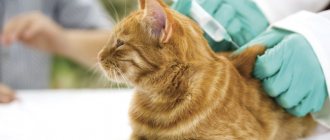I encountered the need to transport my cat Mars when moving.
There was a trip on a long-distance train (RZD) lasting 25 hours (departure in the morning and arrival the next morning). Some friends suggested that I give the cat into good hands so as not to bother with him, but I categorically refused such recommendations, since I consider it a betrayal of the animal to give it to strangers (even not strangers). Honestly, I don’t understand people who can so easily get rid of their pet because of some inconvenience.
In this article I will share my practical recommendations for transporting cats on a Russian Railways train and my impressions of the first trip with a cat on the train.
Veterinary certificate
Back in 2022, every cat owner who wanted to place their animal on a train had to visit a veterinary station and purchase a health certificate for their pet. The validity period of the certificate was limited, so those people who came for it in advance risked being left on the day of the trip with a useless, invalid piece of paper. This document was valid for only five days, which meant that literally a couple of days before the trip the owner had to visit the veterinary station.
Many owners consider visiting the veterinary station the most tedious preparation point
When traveling abroad, two veterinary certificates are required - in Russian and in the language of the country you are traveling to. English is often used as an international language.
Sample of an international veterinary certificate
There were no provisions for any tests on the territory of the veterinary station itself. The cat owner must come with an existing veterinary passport, which contains information about all vaccinations performed and the health status of the animal. Vaccination had to be done no more than a year, and no less than a month before departure.
Required vaccinations
The situation is further complicated by the fact that there is no single list of required vaccines. In this matter, each veterinary station shows itself “creatively”. For some specialists, a rabies vaccination is enough, while others require vaccination against:
- Rhinotracheitis;
- Calcivirosis;
- Panleukopenia.
As a rule, veterinary stations do not inspect animals and issue certificates based on existing documents
It is difficult to predict the vagaries of each specific station, so universal vaccination was the optimal solution. Even before vaccinations, the cat had to be dewormed in order to avoid side effects from vaccination. In short, the pet owner faced a difficult and exhausting journey from the veterinary station to the treasured railway station.
Sedatives for cats
If your pet is nervous on the road or behaves inappropriately, it is better to use sedatives. The list of effective means includes:
- Fitex are special drops that are easy to give during a trip. It is better to use them before boarding the train so that the animal can calm down and endure the journey more easily. It is better to give drops a month before travel, since the product has a cumulative effect.
- Stopstress is a faster and more pronounced effect. It is not addictive, it is recommended to give it in drops.
- Fospasim is a homeopathic remedy whose action is aimed at eliminating fearfulness, panic, stress and aggression.
You can contact your veterinarian in advance and explain the problem of the animal’s behavior on the way. In extreme cases, a specialist injects the cat with a sleeping pill. The cat will sleep for a long time.
Condition of the cat after transportation
After the move, the animal, of course, continues to experience stress. This happens not only because of the transportation itself, but also because the animal ends up in a completely new place for it, in a new apartment.
Basically, the behavior of the animal is as follows:
- refusal to eat for several days (1-3 days);
- refusal to go to the toilet (up to 24 hours after moving);
- the animal does not make contact with the owner, hides under the sofa or in another secluded place.
After 2-3 days, this condition passes and the cat begins to behave as usual. After a week, Mars had already completely settled down - his appetite returned, he began to go to the litter box and behave like the master of the house.
And if abroad, then...
Then you will need a veterinary passport and a certificate of vaccinations, issued in compliance with the rules:
- A veterinary certificate (form No. 5) obtained only in a state clinic, but not in a private clinic, is recognized;
- it is valid only for 5 days after receipt; and for the return trip, a similar document is issued at the clinic of the country from which you are leaving;
- it is issued on the basis of a veterinary passport with notes of the necessary vaccinations, deworming and treatment for fleas, lichen, made during this year, but no later than 30 days before departure - this is the quarantine period;
- The cat must be microchipped, which will be written down in the passport.
We wish you a successful journey and a pleasant holiday with all our hearts!
We will be glad if we could help you with advice. Ask questions and share your experience in the comments. Until next time!
With respect, Edik Skarzhinets.
Reform 2022
If after all these frightening descriptions you go to unload your suitcases, then don’t rush. In January 2022, another amendment was adopted, this time transforming all preparations for the trip beyond recognition. Pet health certificates were abolished. Abolition, however, does not mean a complete lack of control over the pet’s condition on the part of Russian Railways employees.
Don't be confused if you meet an ignorant guide and explain the situation clearly to him
As already mentioned, all orders from above spread to the ground at a snail's pace. Therefore, if you arrive fully armed, with knowledge of the changed legislation, there is no guarantee that you will not meet an employee who will certainly ask you for an animal passport. Moreover, if you call the company and start asking different specialists questions on this topic, you may well hear mutually exclusive information.
Often Russian Railways employees themselves have conflicting information and cannot agree on the issue of transportation
The main points that you should take away from the winter reform are as follows:
- Transportation rules now depend on which compartment you choose. Some types of compartments, which we will talk about next, are not accessible to animals;
- The size of a cat is no longer determined by its physical characteristics, but by the carriage in which the animal is placed;
- You cannot purchase a single “cat” ticket - for each train and each type of car the price is set individually.
- Sleeping and luxury carriages remain inaccessible to cats.
Often Russian Railways employees themselves have conflicting information and cannot agree on the issue of transportation
Despite the fact that having a veterinary passport and related certificates is no longer mandatory, it does not mean that the owner can safely ignore this document. We will talk further about why a veterinary passport is needed and what its useful functions are.
Veterinary passport for a cat
Video - current transportation rules
What to take with you on the road
Most owners, when going on a long journey for the first time, do not know what they need to take with them for their animal.
The following list of items will help:
- Container for transportation. It is required, but a container means a carrying bag, a basket, a house and other items in which the animal will be comfortable. An important condition is that the pet must be in the “house”, so it is recommended to check the condition of the zippers and locks.
- First aid kit. A first aid kit for an animal should contain essential supplies - antidiarrheal and painkillers, antiemetics, antiseptic, bandage and cotton wool.
- Tray with filler. It is recommended to take a special filler that absorbs urine odors.
- Dry diapers are disposable. They are put in a container so that the cat can relieve itself - animals on trips do not always go to the tray after being dropped into it.
- Wet wipes and plastic bags. Will be needed to clean up after the animal.
- Bowls for water and food.
- Leash, collar or harness. Even if you don't keep your cat on a leash, it's a good idea to do so when traveling. The animal may become frightened at the station and run away.
- Warm small blanket. The cat will need it for an overnight stay. It is recommended to take an unnecessary blanket or one that can be easily washed, in case your pet uses it for other purposes.
- Toy. A favorite toy in a container will help your animal cope with stress.
When it comes to toys, you should not purchase a new item before traveling. It should remind your pet of home. Let it be a favorite sock or string, but it gives the cat some protection.
Possible problems and advice from experienced travelers
When planning your trip, you should think about the trip in advance, especially if it will take place with your beloved pet. Forethought will help people and cats endure the road comfortably. The main requirement of any trip is to ensure the safety of all participants - the animal itself, the owner, and other passengers.
Microchip implantation
To move a cat across the country, microchipping is not a requirement. This procedure must be done before rabies vaccination. This is regulated by current EU regulations. The chip itself looks like a small grain, the size of a grain of rice. It is implanted under the skin on the animal’s withers so as not to create discomfort.
A barcode is entered into the veterinary passport, which is also entered into the electronic database. It first appeared in the European Union, then moved to the USA and Canada. In these countries this procedure is mandatory. Owners who fail to do this face a heavy fine.
The main idea of chipping is to make it easier to find “lost items” so that if found, they can be returned to the owner. Also, all information about a given belly is recorded on the chip, including its vaccinations, diseases and other data.
If during the trip the cat opens its mouth and breathes rapidly during transportation, this indicates that it is motion sick. In this case, you can give medications for motion sickness, if possible, provide a flow of clean air, and give water. It is not advisable to feed a cat in this condition.
What does a cat need on the road?
In order for your pet to survive a long trip, you need to have some items with you. Be sure to stock up on the following:
- carrying;
- tray;
- harness;
- water;
- dry food;
- napkins;
- disposable waterproof diapers;
- soft bedding;
- Trash bags;
- sedatives;
- disinfectant against unpleasant odors.
All of these items will be useful, especially during a long trip.
Is a container required for transportation?
A bag for transporting cats is a must, regardless of the chosen transport. It is not recommended to take out an animal while traveling, since in a state of fear it can simply run away, bite, scratch and escape from your hands.
The container must be made of plastic, have a solid bottom, and a mesh. These are the basic requirements that most airlines require for this cat accessory. Although a soft backpack for transporting cats is more convenient for the owner of the animal, it is unlikely to be suitable for a flight.
The nuances of transporting kittens
Many carriers do not accept kittens under four months of age for transportation. This is due to the fact that such kittens, due to their age, cannot receive some mandatory vaccinations. Many of them are placed only at three months, but must undergo quarantine. It is better to transport kittens with their mother. One or more kittens are not allowed.
Sedatives for cats
Using sedatives will reduce your cat's stress. It is advisable to coordinate the choice of a specific drug with your veterinarian. If you plan to travel by plane, sedatives for cats during transportation can be dangerous.
An overdose of the drug can also only cause problems, and sometimes even cause death.
How to prepare a cat for flight
For several days, the cat’s food should be limited, but not completely. Access to water must remain unrestricted. It is worth preparing a carrier, toys and other necessary items in advance.
Carriage rules
Many people love to travel, but if they have pets, this procedure can become problematic, because certain rules must be followed to transport cats and other animals. It is easier to transport a cat on a train than a dog, which is due to its size, however, even for such a furry animal, a lot of documents need to be completed in order for the owner to be allowed to transport the pet. In order to get everything done on time, it is recommended to go through all the authorities at least a month in advance and receive the relevant documents in order to calmly prepare for the trip.
In order for a cat to be allowed on the train, it must be vaccinated and examined by all doctors. Below is what else needs to be done.
- Rabies vaccination - without it, no one will give permission to have a cat on the train. The optimal period for conducting it is considered to be 30 days before the trip, so that the results are relevant and accurate.
- Cleansing the cat’s body of parasites is recommended to be done 1–2 weeks before the planned vaccination.
- Carrying out double vaccination - a procedure necessary if animals have not been vaccinated for several years in a row. Vaccinations are given 20 days apart.
In addition to the mandatory measures, you must have a veterinary passport with you, in which the doctor notes each vaccination, writes the vaccine number, the date of administration, and puts his signature and seal. Without such documentation, there is no point in even trying to bring your pet with you. In addition, a veterinary certificate is very important, which is given in a state veterinary hospital by a doctor who examines the cat no later than three days before travel. This certificate states:
- type of pet;
- the number of animals that will be transported, because one document can be issued for several pets at once;
- age of the cat;
- records of vaccinations and quarantines.
The veterinary certificate in Form No. 1 is valid for three days, so there is no point in obtaining it in advance.
Since collecting all the documents takes a lot of time, effort and money, in 2022 in Russia they changed the rules for transporting animals to Russian Railways, significantly simplifying it. Now the cat needs to buy an additional ticket, because the pet is considered as hand luggage. This rule works if the animal’s weight does not exceed 20 kg. You must have a veterinary certificate with you, valid for 3 days, which is shown when purchasing a ticket and boarding the carriage.
You can leave your pet next to you only in hard carriages - no one will be allowed into the SV or luxury carriage with animals. An adult cat or kitten must be kept in a secure cage with a lock throughout the entire trip. If any of the rules are not followed, the passenger may experience serious problems, including disembarkation from the train.
Preparing for the trip
Before setting off on a long journey with your pet, it is advisable to do a number of simple manipulations that will make the trip easier for both the cat and you in the future:
- Implant a chip into an animal. Despite the fact that this advice sounds somewhat threatening, many owners resort to this procedure. When transporting a cat, the likelihood of its loss increases, and no one can be 100 percent insured. The chip will allow you to determine the location of the cat using a special program in case of its escape and will save you from tedious searches;
The miniature chip does not harm the animal’s body and is not felt by it in any way.
- Give your pet worm prevention three months before the departure date. The absence of the need to have a veterinary certificate should not entail a special lack of responsibility for your pet. This way you will protect yourself and your possible travel companions from possible infection;
Dirofen in the form of a suspension is literally created for pets who cannot tolerate tablets
- Make sure you have all your cat's required vaccinations throughout the year.
Things to remember on the day of your trip
Transporting a cat on a train is always exciting. In order for everything to go well, it is important for the owner to remember the following simple rules on the day of departure:
- Feed the animal at least 1.5 hours before leaving the house. Moreover, it is important not to overfeed the cat so that it does not get seasick and vomit;
On the day of departure, 1-2 hours before the intended transportation, the cat can be given a sedative (for example, VetSpokoin suspension or tablets, Stop-Stress drops, etc.);
Check that all documents are taken with you. In a hurry, you can easily forget something important, without which you will not be allowed on the train;
Don't delay leaving. It is better to arrive at the station with your pet in advance than to be late;
Carrying bag
I will dwell in more detail on the carrying bag. You can purchase either a hard carrier (plastic or metal) or a soft one. I have a soft fabric one with a rigid frame.
I recommend placing a pet diaper (available in pet stores) at the bottom in case the animal goes to the toilet directly in the bag (which is most often excluded). Also, bedding will not hurt if the cat has a plastic carrier. The animal will be more comfortable on a soft diaper or blanket.
Absorbent animal bedding
Mars traveled in such a soft carrier
conclusions
So, let's summarize. Your main actions if you plan to transport a cat by train to the Russian Federation:
- Find your way around the flight.
- Call the Russian Railways help desk (or the carrier) and find out whether pets can be carried on this flight and in which carriage. Find out more about the conditions.
- Issue a receipt for transporting your pet. You can do this in parallel with purchasing a ticket for yourself or after, presenting your ticket when issuing a receipt.
- Buy a durable cat carrier.
Video
Transporting cats on high-speed trains
There is no single set of rules for transporting cats that is valid for every train. Before setting off, the owner should familiarize himself with all the possible options and weigh the pros and cons.
Table 1. Rules for transporting cats on high-speed trains
| Train | Requirements | Price |
Peregrine Falcon | In Sapsan, cats are transported in specially designated places in the third and eighth carriages for economy class passengers. In first and business classes, space for passengers with pets is available in the third carriage. The weight of the container together with the animal should not exceed 10 kg, the container itself should be no more than 120 cm | 900 rubles in first and business class. In other carriages the cost of transportation is included in the ticket |
Swift | On this train, cats can be transported in class 2B carriages. There is strictly one carriage per travel document. Containers must contain no more than two pets. The size of animals when summing up three dimensions (width – height – length) should not exceed 180 cm | The cost of transporting each individual individual is negotiated individually |
Martin | In Lastochka, transportation of cats is permitted in class 2C and 3C carriages. Passengers with animals are allocated special seats in the fifth and tenth carriages. There are also luxury places where you can also accommodate cats, but for an additional fee. A passenger can take one container, which will contain no more than two individuals. The dimensions of pets in the sum of three dimensions should not exceed 180 cm | 150 rubles |
Swallow premium | The difference between the conditions of a premium swallow and an ordinary swallow is the greater number of places for cat lovers, concentrated in the fifth car. For an additional fee, it is possible to reserve seats of increased comfort. A passenger can take one container containing no more than two individuals. The dimensions of pets in the sum of three dimensions should not exceed 180 cm | 150 rubles |
Allegro | Seats for passengers with cats in Allegro are located in the sixth carriage. There are no special seats available for an additional fee. Transported pets must be in containers whose dimensions do not exceed 60x45x60 cm | 15 euros |
General rules for animal owners
Regardless of what animal is about to travel, its owner should know the general rules:
- The carrier reserves the right to determine specific places for delivery of animals. Special signs are installed in train carriages.
- The owner must warn the administrative staff of JSC Russian Railways that the four-legged animal is about to travel.
Rules for transporting cats on trains in the Russian Federation
Russian legislators classify cats as “small (pet) animals.” It also includes dogs of small breeds, birds, lizards, rodents and fish.
The following rules have been developed for owners:
- Pets are placed in special baskets and houses that isolate them from passengers. It doesn’t matter who rides in it, an adult animal or a kitten.
- Large breed cats can fit in a container whose size does not exceed 180 centimeters (the total size of three sides). Such transportation is equivalent to hand luggage and does not require payment for additional space.
- Owners are required to feed their animals and keep the container clean.
- The conductor or controller may refuse to transport a cat if he decides that they pose a danger to the health of other passengers.
- Short distances are covered without being placed in a container, under the constant supervision of the owner.
Rules for transporting Russian Railways animals unaccompanied by the owner - photo instructions
Requirements for the cage and adoption of the animal
Loading and delivery
On long-distance trains
The length of the long-distance train route is more than 700 km. The cost of moving varies depending on the direction the owner and his pet are traveling. For example, transporting a cat over a distance of more than 12,500 km will cost about 3 thousand rubles.
To ensure maximum comfort on the road, experienced owners and management of transport companies advise:
- do not limit the cat’s access to water;
- have a sedative and anti-sickness pills;
- During long stops, walk the cat in the fresh air and give it the opportunity to go to the toilet.
On high-speed trains
Now JSC Russian Railways has launched four high-speed trains: Lastochka, Sapsan, Allegro and Strizh. Stricter rules apply on their routes, which is explained by the carrier’s desire to provide comfortable conditions for passengers.
Cat owners traveling in luxury carriages will have to leave them in a special place and pay above the ticket price.
In “Swallows” the rules for four-legged pets are general; it is only important not to block the passage with a carrier. The rules are the same - there is one animal per passenger, and a ticket for it must be purchased separately. For business class carriages, the requirements are similar to Sapsan type trains.
In Strizhi you can bring a cat according to the same rules, and for an additional fee.
On commuter trains
It is more convenient to transport cats by electric train, since such a journey will be less stressful for them. Moving short distances allows you to hold your furry pets in your arms. There is no need to take a large carrier with you; the supervision of the owner or an accompanying person is sufficient. The ticket costs the same as for one passenger, as it does not include additional services.
Legislative regulation
Every owner must follow the current rules for transporting cats by train. To do this, you need to delve into the essence of the issue and its subtleties.
The portal’s lawyer will help you deal with them; you can send a request to him on the site at any time.
After filling out the pop-up form, the consultant will give advice on the rules for transporting cats on trains.
Regulations for the transportation of animals by rail are mandatory for all passengers. Any citizen, having purchased a ticket, automatically agrees to comply. Violation of these will result in prescribed penalties.
The legislative framework in this area consists of:
- Charter of railway transport No. 18-FZ dated 10/01/2003 as amended in 2022.
- The Order of the Ministry of Transport of the Russian Federation approved the Rules for the transportation of passengers and luggage No. 473 dated 12/19/2013 in the new edition of 2022 certified by the Ministry of Railways of the Russian Federation and standards for the delivery of animals by rail.
Watch the video: “How to transport a cat on a train.”
Useful tips
Transporting a cat on a train is difficult for owners, since during the entire time people are worried about the condition of their family member. You can make the animal’s fate easier by following these recommendations:
- You cannot limit your cat's access to water. Place a bowl of water in the container and constantly monitor its contents.
- At stations you are required to walk your cat. A leash is used for this. Walk with her as far as possible from large crowds of people, but observing safety precautions.
- During a walk, you need to check whether the animal has gone to the toilet. If not, health problems may arise. Sometimes the animal does not go to the toilet, eat or drink during the trip, which can last up to 3 days. In this case, immediately upon arrival you need to contact a veterinarian and explain the situation. The doctor will prescribe treatment to eliminate dehydration and restore the functions of the urinary system.
- For food, it is better to take dry cat food on the road. But if your pet has not tried it before, it is better to keep the same food and provide it on the train. Otherwise, you may experience stomach and intestinal upset.
Monitor your cat's condition closely during the trip. If the situation allows, you can remove the animal, which is on a leash, from the container and hold it in your arms. Or put him to sleep next to you if you know for sure that he won’t run away. To avoid funny things, it is better to tie the leash to the train table.
In addition to our article, we recommend reading the story of one traveler with a cat. You will find a lot of useful information in it - https://pikabu.ru/story/v_poezd_s_kotami_4974906
Travel registration
Nowadays, tickets are purchased in two ways, which determine the specifics of further actions:
- Order a ticket via the Internet. As a rule, on the websites of railway companies, when purchasing a ticket, you can select all the additional functions, which include transporting a pet, which will increase the cost of the ticket. Upon arrival at the station, you just need to show your passport and present the ticket printed from the website;
When ordering a ticket through the website, pay attention to the carriages marked with the letter Z - these are the ones you need
- Purchasing a ticket through the station ticket office. When purchasing a ticket directly, you inform the cashier about the presence of the animal and discuss the package of necessary documents and the final cost of the ticket, after which you redeem it.
It is advisable to notify Russian Railways employees of your intention to transport the animal in advance (two to three days before the day of departure). You can do this by calling the toll-free number 8-800-222-07-66.
The simplest procedure for transporting a cat applies to all trains
Please note that commuter trains do not require containers. It is enough to pay an additional fee for the animal, and entry into the carriage is open.
Travel ticket for a cat - cost and necessity
The price of a “cat ticket” depends on the type of route and the carriage where it is placed:
- Long distance trains. Carriage of a cat is paid additionally in reserved seat, seated and general carriages. If the owner decides to travel in a compartment, then there is no need to pay separately for the animal. The cat carrier should be located in the owner's seat and not interfere with other passengers.
- High-speed trains. If you prefer fast travel, you must remember that you will have to pay extra for a regular ticket on any of the well-known trains of this type. A flat fee applies for four-legged passengers. For a ride in the Lastochka you will have to pay 150 rubles. The cost of transporting cats in an economy class carriage of the Sapsan train across Russia in 2022 is included in the ticket price.
How to transport on an airplane?
Is it possible to transport a cat on an airplane? Yes, if you collect all the necessary documents and prepare for the trip, following the airline's rules and customs requirements.
Airlines usually offer two options for transporting a cat - you can either take it into the cabin or transport it in the luggage compartment. Check in advance what maximum weight animals can be taken on board the plane. Typically this weight is 8 kg. If your cat weighs more, she will have to travel in the luggage compartment.
When purchasing a plane ticket, indicate in advance that you will be traveling with an animal. The fact is that a limited number of animals can travel in the cabin of an airplane on one flight, so you need to communicate your desire to transport a cat in advance. Also check whether you need to pay extra for transporting animals.
Before transporting a cat on a plane in Russia, you need to obtain a certificate from a veterinary clinic, as is the case with train travel.
When buying a plane ticket, immediately order a reservation that allows you to transport animals. Each air carrier has its own rules, we recommend that you familiarize yourself with them in advance.
The fact is that some companies allow pets to be transported in the cabin, others require reservations, and still others prohibit it altogether (the cat is placed in the luggage compartment).
Each airport has a veterinary control post. There you need to put the strain on form No. 1. Upon arrival at your destination, another stamp is placed. If there are transplants, everyone needs to undergo this procedure.
Next, the cat and the container are weighed and the overload is paid. Paying extra money is, of course, unpleasant, but nothing can be done, these are the rules today.
To transport a cat on a plane abroad, you need to do the same as in Russia, but you must have an international veterinary passport.
Required documents
Not so long ago, all cats were required to obtain a special certificate from a veterinarian to travel on trains, and many still think that this is necessary. But since 2022, this requirement has been abolished; a pet will need a veterinary document only if its transportation is directly related to business (for example, if a cat is being transported for sale). In this case, you cannot do without a veterinary passport, which will contain notes about the vaccinations given.
If you are planning a trip with a cat abroad, then you need to find out about the necessary documents for your pet in the destination country. Depending on the final destination of the trip, the set of required papers may vary. For example, for some countries it is mandatory for an animal to have a chip with an individual number.
So the only document needed to travel domestically with your furry friend is a ticket, which may or may not incur an additional fee. Accompanying veterinary documents are not required for traveling within Russia.
If necessary, you will have to pay a separate baggage check for the cat.
We transport it in a car
If you have to transport your cat or kitten long distance by car or just go to the vet, you will need to prepare for this in advance. How to transport a cat and what will you need for this? Even for the shortest trip, you will need a special carrier - after all, always carrying your pet in your arms is impractical and unreliable. There are different types of carriers, and each has its own features and advantages.
There are no requirements as such for transporting a pet in a car, but there are recommendations that are highly advisable to follow.
Before transporting your cat in a car, make sure you have it under control. You can put her in a container or soft carrier, or just keep her on a leash. The main thing is that it cannot move around the inside of the car. This is fraught with the fact that the fluffy will have the opportunity to jump out of the window (on a busy highway this can cause an accident) or interfere with the driver, creating an emergency situation.
The nuances of transporting kittens on trains
Transporting a kitten on a train is no different from traveling with an adult pet - the same requirements and restrictions apply. However, if the baby is going to a new owner, that is, for sale, he will need a completed veterinary passport, which should contain notes on age-appropriate vaccinations and measures taken to eliminate fleas and helminths. It must be taken into account that at least 30 days must have passed since the last vaccination (quarantine after the procedure), therefore the age at which cats can be transported on the train is limited. Thus, the first mandatory immunization against major diseases takes place at 2–3 months, which means that it is simply not possible to bring a kitten for sale that is less than 3–4 months old.
Is it necessary to buy the entire compartment if you are traveling with a pet?
This restriction is established only for SV carriages and luxury cabins. To travel with a cat in a classic coupe, you do not need to buy all the shelves. All you need is a ticket for yourself and a receipt for the transportation of your tailed friend. It does not hurt to clarify detailed information on this issue with the carrier.
- "Allegro" - transportation on a paid basis in the places provided for this.
- "Sapsan" - carriage on a paid basis in economy, business and first class carriages in designated seats. At the same time, only one animal or bird can be issued for one ticket. Placing more than two pets in one place is also prohibited. In a negotiation compartment, you are allowed to carry no more than one pet per seat and no more than four animals per compartment.
- "Strizh" - transportation is paid in a "2B" type carriage.
- "Swallow" - travel is paid in special places. No more than one pet per ticket and no more than two per seat.
Not all carriages of JSC FPC allow pets, so before purchasing a ticket, you should make sure that such a service is provided in the carriage. If the train belongs to another carrier, you should clarify in advance exactly how the process is carried out.
If, in the opinion of Russian Railways employees, a large animal poses a potential threat and may be dangerous for passengers, their owners may be denied transportation.
As for larger dogs, they should be transported in a vestibule, kept on a leash and muzzled. However, the presence of more than two large dogs in one carriage is not allowed. You will also need to pay additional transportation fees.
Video about transporting animals
The travel of pets on trains with their owners is subject to strict rules. It is not possible to carry out transportation in all types of wagons. Before buying a ticket, you should check with the cashier whether transporting animals is allowed and how much it will cost.
General principles for all directions and animals
- Animals can only be transported in places designated for this purpose. Below is a table with detailed conditions. You and your animals will not be allowed into other carriages or other seats.
- You can pay for the transportation of an animal on the train at the station before the train departs. From January 10, 2022, a veterinary certificate is no longer required to transport animals.
- Only pets can be carried in passenger carriages. Wild animals, bees, etc. transported in the baggage car of the same train in which the accompanying person is traveling.
- You must feed the animals yourself. Make sure that they do not spoil the sanitary and hygienic conditions in the carriage, too.
- The carry-on baggage allowance per passenger does not include animals. The rules apply both on trains owned by Russian Railways and on others.
- When traveling abroad by rail, be sure to check the conditions for importing animals into a specific country. Vaccinations, documents, the need for microchipping, types of pets allowed for import, etc. vary greatly.
- Blind passengers carry guide dogs with them free of charge in carriages of all categories; no registration is required. The dog must be at the feet of the passenger it is accompanying. When traveling abroad, it is better to check the conditions separately.











